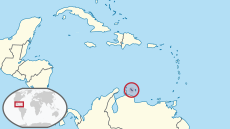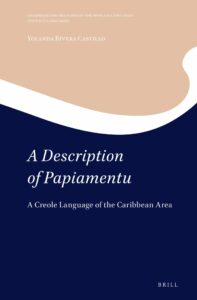A new book has just appeared, describing and analysing the grammar of Papiamentu, the principal language of Aruba, Bonaire, and Curacao (aka the ABC islands), three islands off the coast of Venezuela. It is the first in a new book series from Brill Publishers edited by Peter Bakker, dedicated specifically to contact languages, including pidgins, creoles and mixed languages.
As the world is home to an estimated 7,000 different languages, you have to ask yourself why you would want to spend time looking specifically into Papiamentu. Does this language in any way stand out as special or unique?
In fact, it does.

First of all, Papiamentu is a creole language. This means that, like other creole languages, it was formed in the colonial period, as a result of the sudden and intense contact between a host of different African and European languages. Compared to traditional languages such as Spanish or Danish who gradually developed out of other, older languages, creole languages are, in other words, extremely young languages.
Now, for that very reason, creoles can offer us unique windows into processes of language creation and language change that older, traditional languages cannot. We can observe, for instance, how these languages started life as rather basic communicative systems with small vocabularies (jargons/pidgins), which over time can be seen to develop into fully functional native languages – creole languages – with an innovative grammar that, despite its young age, possesses the same expressive potential as older, traditional grammars.
But there are things that make Papiamentu special even within the family of creole languages.

Although the ABC islands were under Dutch colonial rule between ca. 1650 and 1950, the core vocabulary of Papiamentu is, surprisingly, derived mainly from Spanish and Portuguese. Other well-known creole languages, such as Jamaican, Haitian, or Cape Verdean, have a vocabulary that is for the most part derived from the colonial prestige language. In the case of Jamaican, for instance, that means the vocabulary is for more than 90% derived from English; for Haitian, it’s mainly French, and for Cape Verdean, it’s Portuguese.
Admittedly, some 30-40% of the overall Papiamentu vocabulary is derived from Dutch, but this contribution was clearly added more recently, and is comparable to the influence of French on English in that it concerns mainly the periphery of the lexicon.
Also, as noted, the basic lexicon is not from one but from two main sources: Spanish and Portuguese. The Spanish and Portuguese words are distributed in a remarkable way. The names for basic concepts (nouns and verbs) are predominantly Spanish: for example Pap. muhé ‘woman’, homber ‘man’, hasi ‘to make, do’, from Sp. mujer, hombre, hacer. But grammatical words are more frequently derived from Portuguese, such as Pap. lo ‘future tense marker’, na ‘in’, te ‘until’, nos ‘we’, -mente ‘nominaliser’, from Port. logo ‘later’, na ‘in the’, até ‘until’, nos ‘we’, -mente. Scholars do not yet agree as to what might have caused this unusual state of affairs.
Thirdly, whereas most creole languages struggle to obtain official recognition and social prestige, Papiamentu is a real success story by comparison. At present, the language enjoys a lot of social prestige and is used in all socio-cultural domains including arts, education, politics and media.
The language has received a fair amount of scholarly attention as well, and can count with a number of linguistic descriptions. So where and how does the current description fit in?

For those looking for an easy-to-read introduction into the language, or for more discussion of its history and origins, this book is not it. It is a description of the grammar, written in a fairly technical, specialist style, following a formal descriptive framework. In other words, the main target audience consists of trained linguists (and perhaps graduate students of linguistics).
To quote the author, the book takes a “functional-typological approach” (p. 6) in order to provide “formal explanations and relations of entailment, conjunction, disjunction, or negation between features” (p. 6).

The book takes the reader through morphology (chapter 2), syntax (chapters 3 and 4), and word and syllable structure (“Segmental features”, chapter 5), before spending a great deal of attention to prosody, intonation and lexical prominance (chapter 6). That is not surprising, since the author specialises in the latter area. And an interesting area it is: Papiamentu is considered unique amongst creoles in that it can use both stress and tone to distinguish between two otherwise homophonous words.
A discussion of the verbal system is provided in chapter 7 titled “Sentential Semantics”. The final chapter (chapter 8) offers a summary discussion of the typological nature of the grammar of Papiamentu in particular and of creole languages in general. The author’s main conclusion is that “the features found in Papiamentu are attested in other natural languages” (p. 208) and that, as a consequence, “we reject the idea that there is a special process called “creolization”“ (p. 208). Although I disagree with these conclusions (be it in regards to Papiamentu specifically, or in regards to creole languages in general), it is nevertheless good to see the author take such an unequivocal stance, as such clarity is a way of inviting – rather than avoiding – debate.
In sum: if you’re hoping for an easily accessible introduction into the grammar or history of the Papiamentu language, this book is not going to be your cup of tea, but people with a keen interest in general linguistics and/or creole languages will find plenty to enjoy.
 Bart Jacobs is a Dutch linguist who specializes in creole languages in general, and Papiamentu in particular. Since Papiamentu combines Spanish, Portuguese and Dutch words, the language turned out to be a perfect object of investigation for Bart Jacobs as he was studying Spanish and Portuguese linguistics at the University of Amsterdam in the mid-2000s. He went on to write a doctoral thesis on the origins of Papiamentu, claiming that the creole was in fact imported from the Cape Verde Islands (Jacobs 2012), a theory that is slowly but gradually gaining traction amongst colleagues. He has since written a number of articles on Papiamentu and other creole languages.
Bart Jacobs is a Dutch linguist who specializes in creole languages in general, and Papiamentu in particular. Since Papiamentu combines Spanish, Portuguese and Dutch words, the language turned out to be a perfect object of investigation for Bart Jacobs as he was studying Spanish and Portuguese linguistics at the University of Amsterdam in the mid-2000s. He went on to write a doctoral thesis on the origins of Papiamentu, claiming that the creole was in fact imported from the Cape Verde Islands (Jacobs 2012), a theory that is slowly but gradually gaining traction amongst colleagues. He has since written a number of articles on Papiamentu and other creole languages.







